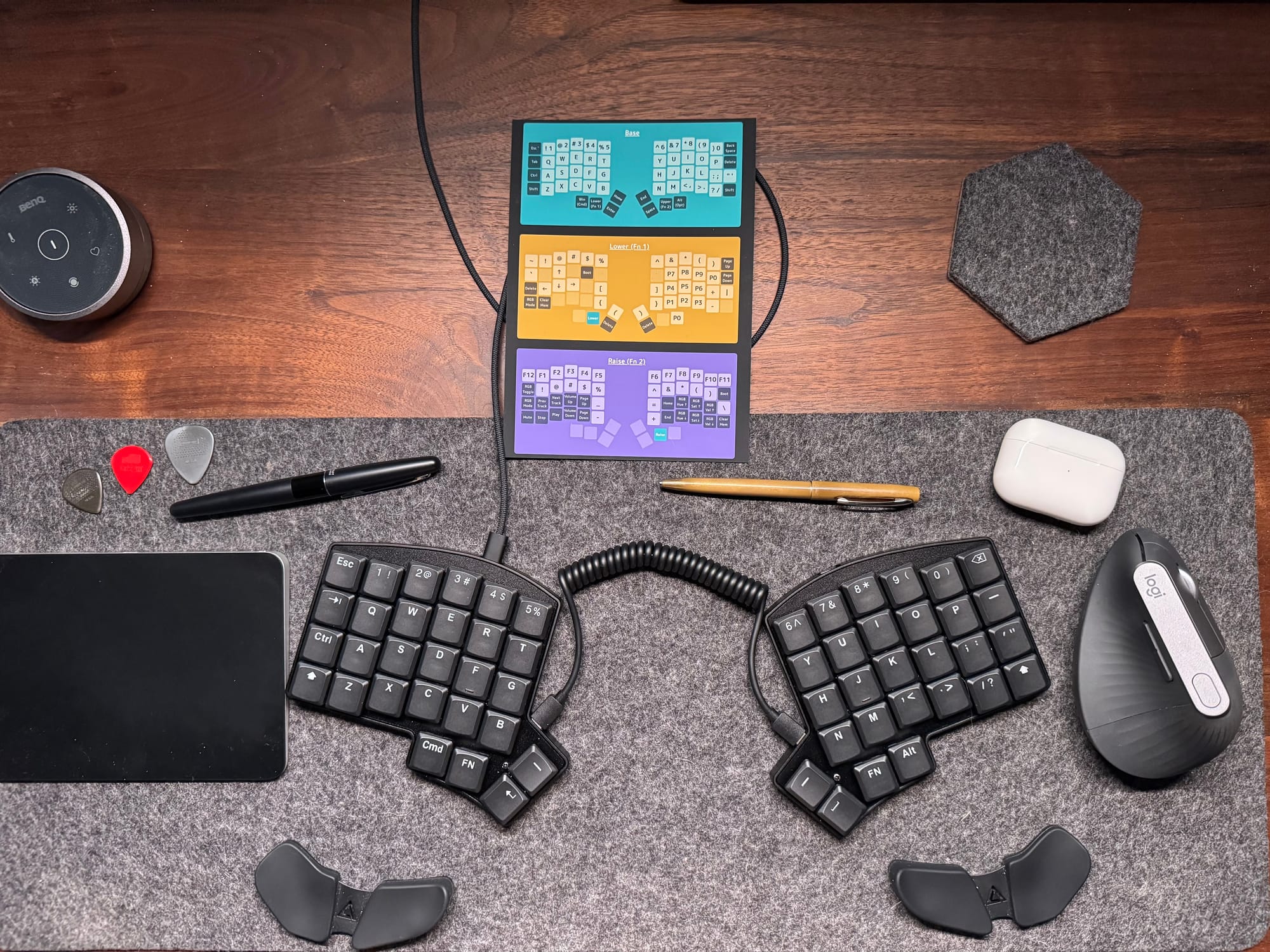Words Per Minute and the Tyranny of Efficiency

I recently bought myself a new keyboard, and it's made less efficient. Allow me to explain...
For as long as I've been using a computer, I've been using a standard QWERTY keyboard to type on. In brief, the QWERTY layout dates back to the 1870s when typewriter manufacturers developed a method of offsetting or staggering the rows of keys to allow the physical levers to move properly (as seen in the header image above). This prevented adjacent keys from frequently-typed letters from jamming together. This same layout transferred to electric typewriters and computers to ease the transitions for trained typists. Moving on from the history lesson...
Let’s consider how we typically use a staggered keyboard.
The device is positioned in front of you, narrower than the span of your arms, forcing you to angle your wrists to type effectively. This posture is far from ergonomic. Here are the key issues:
- Issue 1 – Misaligned keys. For instance, when pressing the D key followed by the E key, you must move your finger upward and slightly to the left. While you may be accustomed to this, wouldn’t it be more efficient if you could move straight up?
- Issue 2 – Wrist angling. Holding your wrists at an angle for extended periods—hours a day, year after year—can lead to repetitive strain injury (RSI).
- Issue 3 – Arm positioning. Angling your arms inward closes your chest. Maintaining this posture for long durations weakens back muscles and may cause pain in the back and shoulders.
- Issue 4 – Limited reach. Many keys are difficult to access without moving your entire hand, which often requires further wrist angling.
About eight months ago, I started to notice some pain in my wrists after extended typing sessions. With a family history of carpal tunnel and wrist pain and as a musician who wants to keep arthritis at bay for as long as possible, I decided to take action on my desk ergonomics. I already bought a vertical mouse in August, but I decided to take it a step further and go with a Split Columnar Staggered keyboard. Specifically, the Keeb.io Iris.

It's key (heh) features:
Split
The keyboard itself is split in half, which helps solves the awkward angle in the wrists, with claims to help reduce ulnar deviation. the cable in the middle can also allow the "sides" to spread apart and allow your arms to angle straight out, opening up your chest and shoulders.
Columnar Staggered
The keys are arranged in columns, allowing your fingers to move up and down more naturally rather than unnecessary lateral motion. In addition, the columns are staggered to match the length of your fingers.
Time to slow down...
Before starting my journey with this beast, I considered myself a pretty average typist, somewhere between hunt-and-peck and touch-typing (58 words per minute or WPM). The first couple days of typing on the Iris, I was at about 18 WPM. Yikes.

But as the days went on and I kept practicing, I began to build a new rhythm. I began to develop new muscle memory and have now begun to up my WPM. But the first couple days were brutal. Praise the Lord for spellcheck!
This forcible slowing down caused me to reflect on our lives in a way. Ben Franklin is credited with the aphorism "Time is money", and we live in a world where that is more true than ever. Countless books have been written on productivity, habits, and efficiency, and things like Standard Operating Procedures exist in our workplaces. Don't get me wrong, efficiency and being productive are good traits to have, but there is also merit to the rhythm of rest and to take some deep breaths once in a while.
In the first book of the Bible, after God creates everything He rests. My study Bible has this note in Genesis 2:
The creation cycle was completed on the sixth day, and God rests on the seventh, providing people with a model for the cycle of labor and rest. No mention is made of “evening and morning,” perhaps because the Sabbath ordinance continues and people are exhorted to participate in it, and to look forward to the eternal redemptive Sabbath rest.[1]
Rest must be part of our own soul-care. We are all called to imitate the pattern of our Lord, and the rest we take from our tasks ultimately serves as a reminder of the divine rest that we will one day experience.
Come to me, all who labor and are heavy laden, and I will give you rest.[2]
I set out on this keyboard adventure with the goal of ergonomics in mind, but I was also reminded of the rhythms of rest we must have in our lives as well.